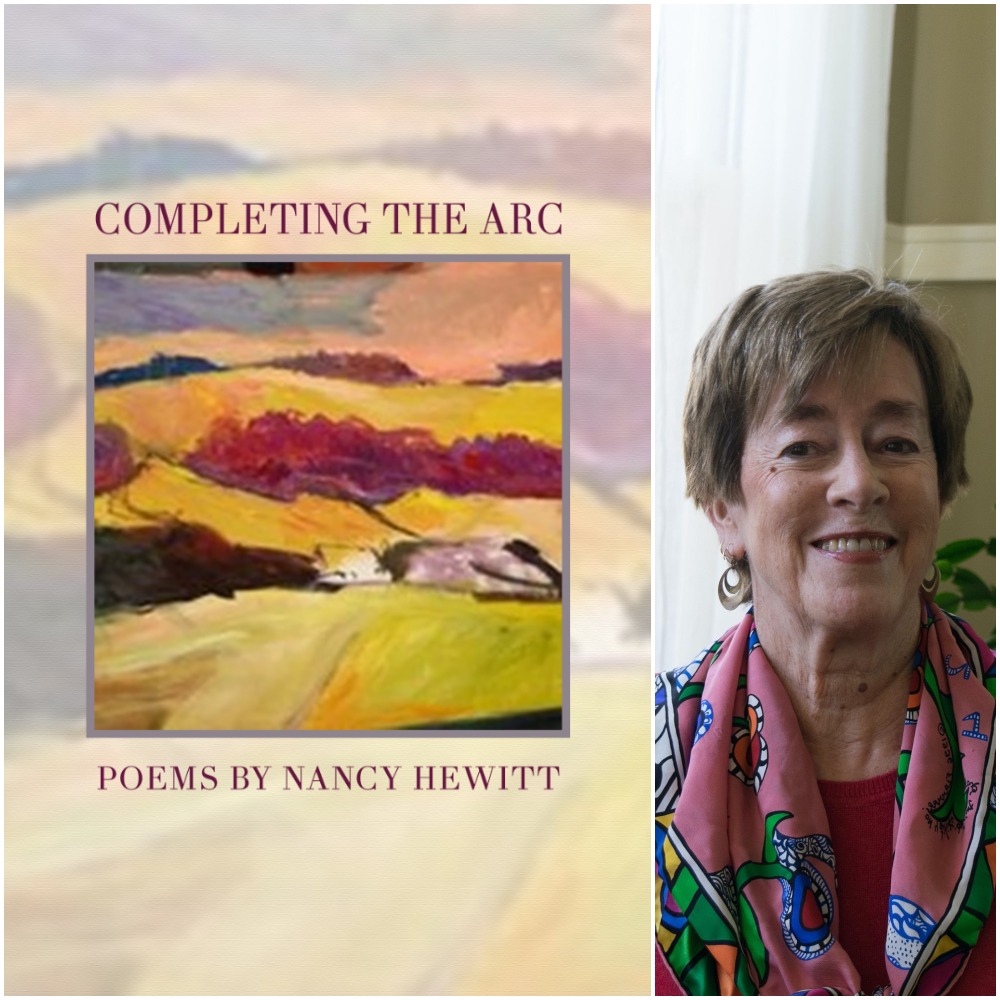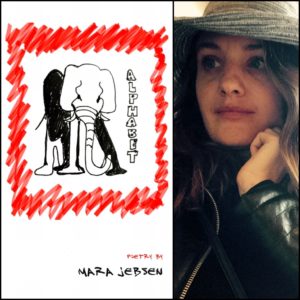COMPLETING THE ARC by Nancy Hewitt
$14.99
W.H. Auden says poetry is “a clear expression of mixed feelings,” and that’s one of the gifts in this compelling book of poems. Nancy Hewitt traces the movement from the constrictions of a 1950’s childhood, content to draw within the lines, to an adult freedom in which she can say, “I use language to open the skies.” The speaker does not shy away from trouble, but traces the complex entanglements of family narrative with insight and compassion. Art and travel become ways the world opens up for this speaker, as when she visits the Guggenheim and learns “the fine art of looking out and up.” Indeed, she looks and sees with remarkable clarity. There’s a fine tension here between the need for measure and the longing for abundance, and amazingly these poems give us both through their shapely forms and vivid moments of transport. Hewitt is a poet of rich vision and intelligence, and this is a beautiful book.
–Betsy Sholl, author of House of Sparrows
Nancy Hewitt’s beautifully crafted chapbook begins in childhood and ends in wisdom. Visual art provides a frequent counterpoint to the harsh realities the poet remembers and, in the wider world, observes. Most centrally “there’s the light offered up by words,” which fill the poems with vivid images and narratives that will linger long in the reader’s mind.
–Martha Collins
“No ideas but in things.” Nancy Hewitt proves the point of that William Carlos Williams line in her new collection. Here are poems about a trailer park childhood where her parents’ volatile marriage is on display. Here, many inventive prose and ekphrastic poems. Here, landscape poems of Barcelona and San Miguel de Allende, Mexico, awash in oh, so much color and light, “the light offered up by words,” as Hewitt says in her title poem. Her words, that light—here now for you.
—Moira Linehan, author of Toward and & Company
Description
COMPLETING THE ARC
by Nancy Hewitt
$14.99, paper
978-1-64662-899-5
2022
Nancy Hewitt’s love of language, story and poetry evolved alongside her 35-year career as a clinical social worker. Her chapbook Heard was published in 2013 by Finishing Line Press. Her poems have appeared in Spoon River Poetry Review (Editor’s Prize), Mid-American Review, Connecticut River Review, Phoebe Journal, Halcyone Magazine, The Ekphrastic Review, Ellipsis and other journals. Her chapbook This Slanted Scene was a finalist for The Poetry Box award in 2019. She has received nominations for the Pushcart Prize and for Best of the Net. She received her MFA from the Vermont College of Fine Arts and was the first Poet Laureate of Swampscott, MA. She finds inspiration in the Vermont countryside, in art and in travel.






Mike Lewis-Beck, Rural Routes –
Completing the Arc contains sadness, but sadness often softened by the joy human foibles can inspire. It’s a delightful read, full of a sensibility readily shared, especially if you are simpa. I savor these, mostly prose, poems. Below I offer favorite lines or line fragments from different entries, beginning with the title poem, Completing the Arc where “I remember the slant of light on the empty green bottle of Rolling Rock…” Yes! I say.
In At the Guggenheim, “I’d never been with orange before.” Riveting.
Duck and Cover. “Most families, he assured us, had built a bomb shelter…” The craft here is brilliant and it dug right into me, as I actually remember such a classroom film.
After Morning Housework. “Then the women were free/to gossip, share recipes, review new brands of cake mixes,” I think of my mom’s canasta club.
Willing. “a father stares into his whiskey glass and a mother’s gaze/lingers on every headlight, willing/” Seems we have similar parental experiences…
Last Egg in the Box. “If this were the last egg on earth,/what would you want it to birth?” Profound wit, yours.
Here in the Dust. “I go back to the work of the dusty farmyard..” Oh am I there. I have a poem entitled Chicken with its Head Cut Off.
Burial. “my husband says/it’s the last time he can do this,” I love cats and the burial is rough, and so symbolic.
Nancy, thank you so so much for these lovely poems, now spreading out into the world.
Diana Kinch, Nancy’s co-member of the Kitchen Table Writers (verified owner) –
Completing the Arc, the poem and this beautiful collection, is such a poignant and personal history of a life painted in words, color and light. I love how self-discovery is
highlighted in At the Guggenheim or Working-Class Girl Meets Rothko by the line, “…I’ve been schooled in calmer sunsets…” or in the poem Here in The Dust with the line, “…to feel these warm stones under my feet, to be surrounded by color…”
Phrases such as coffee klatch afternoons, hours by the window in a Lucky Strike Fog, or spaghetti growing thick as worms made such a visceral impression on me; I savored every line.
Linda V. Hewiit (no relation to Nancy) (verified owner) –
The poems in Completing The Arc pull readers into a world of stunning visual images, childhood memories, and mature insights as Nancy Hewitt uses “language to open the skies.” Beautifully rendered details of moments suffused with the rural beauty of Vermont and the urban energy and color of Barcelona, Lisbon, New York, and San Miguel de Allende engage the heart and mind as we join her intricate journeys through past and present. And her affinity for ekphrastic poems bring the reader new ways to perceive Rothko, Miro, Howard Hodgkins, and other artists. The “light offered up by words” (“Completing the Arc”) illuminates equally the beauty she sees everywhere and the ugliness, loss, and pain we can’t escape. In “All Saints’ Eve,” the poet glimpses “a shimmer of scarlet and fuschia/geraniums in wan sun” and remembers “the burnished coats” of foxes in a dream before she describes an elderly neighbor who, out of wood, begins to burn his books to keep his stove ablaze. “Staying alive is no easy matter,” she writes, and poems like these offer readers the consolations of exceptional art.
Betsey Edwards (verified owner) –
This reader searches for themes in poetry collections, perhaps as this poet looked for precision in her Home Economics class measurements. Maybe we’re both comforted by imagining meaning in the “arc” of our lives, as we lurch from the 50’s into the millenium. Or as we both resist and redeem our mothers when they seem to appear everywhere, suffocating us in their cigarette clouds or popping up in the wider spaces of our grown-up explorations. Whether we share a trajectory from trailer to tropics, or we live right where we originated, Hewitt’s imagery brilliantly illustrates our human journey. As another writer has said, “Wherever we are, there we are,” and there is our history as well.
In “Completing the Arc”, Nancy writes both tenderly and fiercely about her own search, beginning to present. And she doesn’t skimp in the pitch-perfect detail of the many midpoints. She describes her own broken crayons, her dead cat, her captivation with Rothko, her loving terror of her frustrated father — it’s all here, and much more. It’s a universal “arc”, even as the pathway is uniquely hers. I loved every crystalline word. I was blown away by its evocativeness. And I was totally drawn in by the overweening empathy. Both appear over and over again in the beautiful accuracy of Nancy Hewitt’s poetry.
Linda V. Hewitt (verified owner) –
The poems in Completing The Arc pull readers into a world of stunning visual images, childhood memories, and mature insights as Nancy Hewitt uses “language to open the skies.” Beautifully rendered details of moments suffused with the rural beauty of Vermont and the urban energy and color of Barcelona, Lisbon, New York, and San Miguel de Allende engage the heart and mind as we join her intricate journeys through past and present. And her affinity for ekphrastic poems bring the reader new ways to perceive Rothko, Miro, Howard Hodgkins, and other artists. The “light offered up by words” (“Completing the Arc”) illuminates equally the beauty she sees everywhere and the ugliness, loss, and pain we can’t escape. In “All Saints’ Eve,” the poet glimpses “a shimmer of scarlet and fuschia/geraniums in wan sun” and remembers “the burnished coats” of foxes in a dream before she describes an elderly neighbor who, out of wood, begins to burn his books to keep his stove ablaze. “Staying alive is no easy matter,” she writes, and poems like these offer readers the consolations of exceptional art.
Karen Samuelson (verified owner) –
Nancy Hewitt’s narrative poetry is layered with emotion and colorful imagery that remains with the reader: Lucky Strike smoke, listening for tires on gravel with both hope and trepidation. Could this time be different? There is sadness and revelation in many lines: “Trouble has so many measures.” “How often we look away.” Hewitt doesn’t look away and takes us with her making us see and feel both the beauty and the pain in “Completing the Arc” from childhood until now.
L Berrington (verified owner) –
In Barcelona, examining Miro’s canvasses, says Hewitt, “I’ve crossed over the distance / that visitors are required to keep./ I lean in close enough to see / brushstrokes”—and so she considers her own past, crossing the distance, leaning into the hues and the details.
A world press photo exhibit is an assault on the viewers’ senses and sensibilities, each image bleeding into the next. In Hewitt’s poem about the event, we barely know where one vignette ends and the next begins. She approaches her own life similarly. The poet as a stressed, vigilant child was careful to color between the lines. As an adult in retirement, Hewitt crafts poems that break boundaries, jumping between references. Each piece is self-contained. Yet cumulatively they reconstruct sections of a life story, at times situating individual and family experience within its global context.
The collection mourns lives insufficiently lived. Hewitt’s alcoholic, volatile father presented a far more potent threat to his family than a Soviet nuke for which she and her classmates were taught (absurd) “survival” protocols. Her mother, leaving paid domestic servitude for marriage, found in housewifery at first rescue (“the clean smell of steam when she ironed”), then revenge (weaponizing a flatiron studded with rusty nails). A conscientious 10-year-old retrieved a bicycle from a railway line, was killed by the train, re-emerged as a poem. Kayla shot herself. Even so, this collection has a lightness born of freshness, compassion, color, and acute observation, and is never weighed down by self-pity.